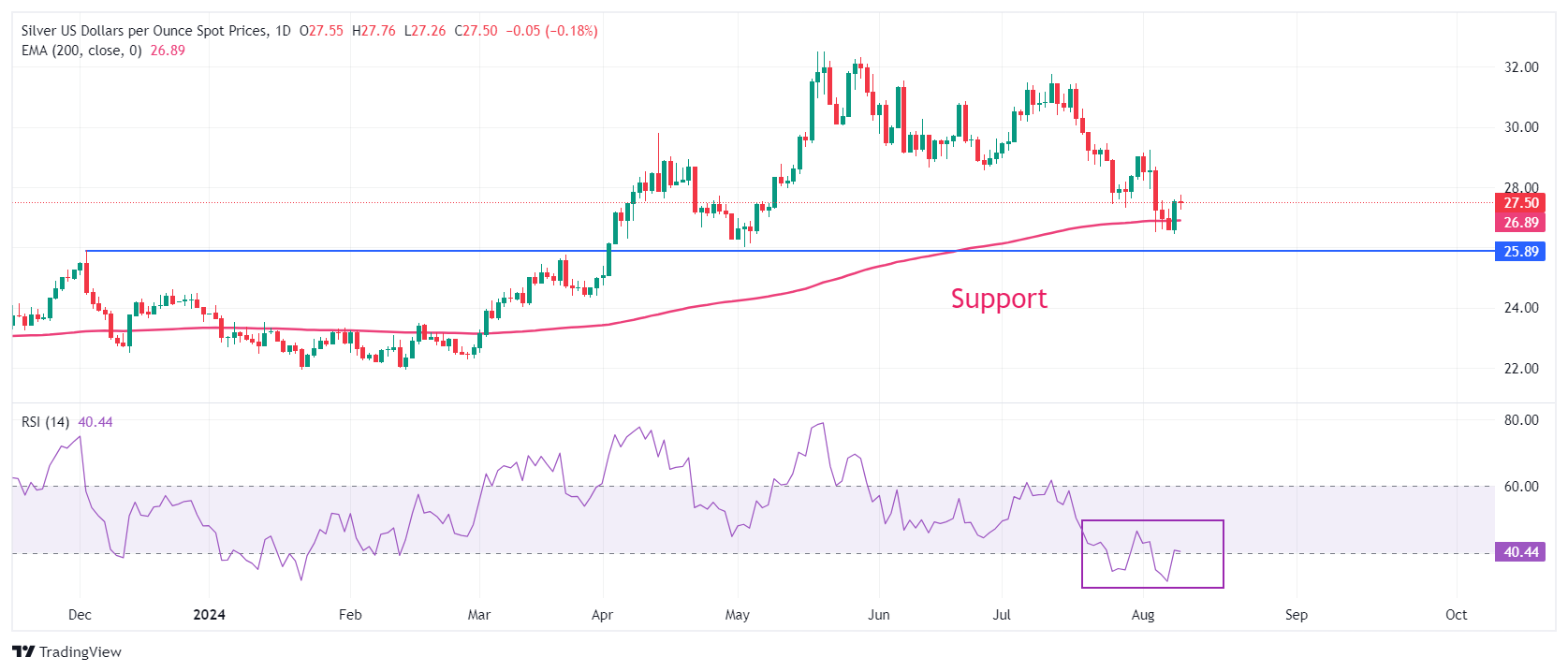- Analytics
- News and Tools
- Market News
- Silver Price Forecast: XAG/USD holds $27 as Fed looks set to cut interest rates in September
Silver Price Forecast: XAG/USD holds $27 as Fed looks set to cut interest rates in September
- Silver price clings to gains above $27.00 as Fed rate cuts in September seems imminent.
- Investors divided over size of Fed’s interest-rate cuts in September.
- Fears of global slowdown have been diminished by lower US jobless claims and China’s hot inflation data.
Silver price (XAG/USD) holds onto gains above the crucial support of $27.00 in Friday’s New York session. The white metal clings to gains as a move towards policy-normalization from the Federal Reserve (Fed) seems certain in September. However, investors divide over the size of interest-rate cuts.
According to the CME FedWatch tool, 30-day Federal Funds Futures pricing data shows that traders see a 56.5% chance that interest rates will be reduced by 50 basis points (bps) in September. The likelihood of 50 bps rate cuts has dropped in a week as fears of global slowdown have diminished after lower-than-expected United States (US) Initial Jobless Claims and hot China’s Consumer Price Index (CPI) data for July.
The US Dollar (USD) exhibits a subdued performance as Fed rate cuts in September seems certain. The US Dollar Index (DXY), which tracks the Greenback’s value against six major currencies, corrects to near 103.15 from four-day high of 103.50. 10-year US Treasury yields slump to near 3.93%.
Historically, lower yields on interest-bearing assets bodes well for the Silver price. But in this case the Silver price is slightly down as investors worry about its global demand as a metal, with application in various industries.
Silver technical forecast
Silver price declines toward the horizontal support plotted from 4 December 2023 high of $25.90 on a daily timeframe. The asset hovers near the 200-day Exponential Moving Average (EMA) around $26.90, suggesting that the overall trend is uncertain.
The 14-day Relative Strength Index (RSI) attempts to return inside the 40.00-60.00 range. A bearish momentum would conclude if the RSI (14) manages to do so.
Silver daily chart
Silver FAQs
Silver is a precious metal highly traded among investors. It has been historically used as a store of value and a medium of exchange. Although less popular than Gold, traders may turn to Silver to diversify their investment portfolio, for its intrinsic value or as a potential hedge during high-inflation periods. Investors can buy physical Silver, in coins or in bars, or trade it through vehicles such as Exchange Traded Funds, which track its price on international markets.
Silver prices can move due to a wide range of factors. Geopolitical instability or fears of a deep recession can make Silver price escalate due to its safe-haven status, although to a lesser extent than Gold's. As a yieldless asset, Silver tends to rise with lower interest rates. Its moves also depend on how the US Dollar (USD) behaves as the asset is priced in dollars (XAG/USD). A strong Dollar tends to keep the price of Silver at bay, whereas a weaker Dollar is likely to propel prices up. Other factors such as investment demand, mining supply – Silver is much more abundant than Gold – and recycling rates can also affect prices.
Silver is widely used in industry, particularly in sectors such as electronics or solar energy, as it has one of the highest electric conductivity of all metals – more than Copper and Gold. A surge in demand can increase prices, while a decline tends to lower them. Dynamics in the US, Chinese and Indian economies can also contribute to price swings: for the US and particularly China, their big industrial sectors use Silver in various processes; in India, consumers’ demand for the precious metal for jewellery also plays a key role in setting prices.
Silver prices tend to follow Gold's moves. When Gold prices rise, Silver typically follows suit, as their status as safe-haven assets is similar. The Gold/Silver ratio, which shows the number of ounces of Silver needed to equal the value of one ounce of Gold, may help to determine the relative valuation between both metals. Some investors may consider a high ratio as an indicator that Silver is undervalued, or Gold is overvalued. On the contrary, a low ratio might suggest that Gold is undervalued relative to Silver.
© 2000-2025. All rights reserved.
This site is managed by Teletrade D.J. LLC 2351 LLC 2022 (Euro House, Richmond Hill Road, Kingstown, VC0100, St. Vincent and the Grenadines).
The information on this website is for informational purposes only and does not constitute any investment advice.
The company does not serve or provide services to customers who are residents of the US, Canada, Iran, The Democratic People's Republic of Korea, Yemen and FATF blacklisted countries.
Making transactions on financial markets with marginal financial instruments opens up wide possibilities and allows investors who are willing to take risks to earn high profits, carrying a potentially high risk of losses at the same time. Therefore you should responsibly approach the issue of choosing the appropriate investment strategy, taking the available resources into account, before starting trading.
Use of the information: full or partial use of materials from this website must always be referenced to TeleTrade as the source of information. Use of the materials on the Internet must be accompanied by a hyperlink to teletrade.org. Automatic import of materials and information from this website is prohibited.
Please contact our PR department if you have any questions or need assistance at pr@teletrade.global.
















